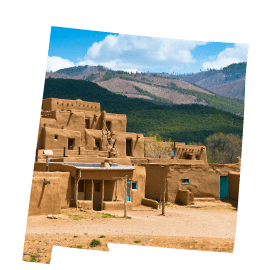Alternate Route Preparation: New Mexico
Expanding the Pool of Teachers Policy
Analysis of New Mexico's policies
New Mexico does not ensure that its alternate route candidates will receive streamlined preparation that meets the immediate needs of new teachers.
New Mexico provides alternative certification through two pathways, approved preparation program or portfolio review.
For candidates completing a preparation program, coursework must consist of 12-21 credit hours. The state requires all candidates, whether in an approved program or through portfolio review, to take coursework in the teaching of reading.
Providers of an alternate route program are required to include a student teaching or field placement component. For both routes, New Mexico offers a mentoring program for at least one year and not more than three years. The program is designed by the local district and approved by the State Board of Education.
After one year of teaching, candidates receive an internship that is good for three years. After three years and successful program completion, candidates may apply for a standard license.
Recommendations for New Mexico
Establish coursework guidelines for alternate route preparation programs.
New Mexico is commended for requiring all applicants, even those in the portfolio review process, to take courses in the teaching of reading. However, for the remainder of the coursework, simply mandating coursework without specifying the purpose can inadvertently send the wrong message to program providers—that "anything goes" as long as credits are granted. However constructive, any course that is not fundamentally practical and immediately necessary should be eliminated as a requirement.
Ensure that new teachers are supported in the first year of teaching.
New Mexico should provide more detailed guidelines for its induction program to ensure that new teachers will receive the support they need to facilitate their success in the classroom. Effective strategies include practice teaching prior to teaching in the classroom, intensive mentoring with full classroom support in the first few weeks or months of school, a reduced teaching load and release time to allow new teachers to observe experienced teachers during each school day.
Ensure program completion in less than two years.
New Mexico should consider shortening the length of time it takes an
alternate route teacher to earn standard certification. The route
should allow candidates to earn full certification no later than the
end of the second year of teaching.
State response to our analysis
New Mexico had no comment on this goal.
Select another topic
Delivering Well Prepared Teachers
- Admission into Preparation Programs
- Elementary Teacher Preparation
- Elementary Teacher Preparation in Reading Instruction
- Elementary Teacher Preparation in Mathematics
- Middle School Teacher Preparation
- Secondary Teacher Preparation
- Secondary Teacher Preparation in Science
- Secondary Teacher Preparation in Social Studies
- Special Education Teacher Preparation
- Assessing Professional Knowledge
- Student Teaching
- Teacher Preparation Program Accountability
Expanding the Pool of Teachers
Identifying Effective Teachers
- State Data Systems
- Evaluation of Effectiveness
- Frequency of Evaluations
- Tenure
- Licensure Advancement
- Equitable Distribution

